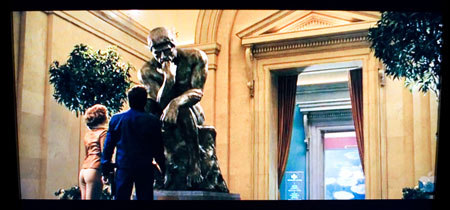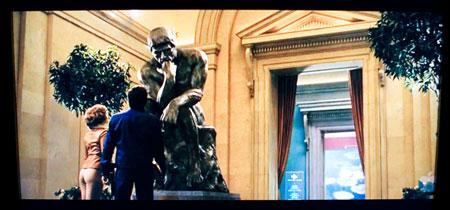A question that always intrigues me when Hollywood intersects with the world of museums is how truthfully our institutions are portrayed on film. What art or historical objects are featured and why? What liberties (and there are many) are taken? Even if it might be a little harder for me to suspend my disbelief, I enjoy the fictions created and always have fun deconstructing such movies from an insider’s perspective. I was happy to say yes when Unframed asked me to check out Night at the Museum: Battle of the Smithsonian.
One instance of directorial license I noticed is that many of the key scenes in the movie take place in the stately interiors of the National Gallery of Art in Washington, D.C., which is not part of the Smithsonian Institution. And many of the featured artworks, which come to life, facilitate time travel, and interact directly with the protagonists, don’t even belong to the National Gallery or the Smithsonian. Instead we see iconic American paintings from the Art Institute of Chicago—Edward Hopper’s Nighthawks and Grant Wood’s American Gothic.

The movie is populated with lots of other world-famous works set in the National Gallery space, like Rodin’s Thinker, which is transformed into a dolt of a he-man, and the classic black and white photograph—enlarged to take precedence over the painted masterpieces hanging adjacent—from Life magazine's coverage of VJ day in August 1945: Alfred Eisenstadt’s unforgettable Times Square Kiss. And this is not to mention Jeff Koons’s gigantic Balloon Dog prancing around the halls of the museum!
Then there is the real Smithsonian, from the National Air and Space Museum, to the Castle on the Mall in Washington, D.C., and the largely imaginary subterranean “federal archives,” which all figure prominently in the plot. Underground we see historical figures from outmoded dioramas come to life: General Custer, Sacagawea, Napoleon, Ivan the Terrible, and the Egyptian pharaoh Kamunrah, who has enthroned himself in the Castle in Archie Bunker’s easy chair on top of a mountain of other objects looted from the Smithsonian’s vast collections (including Dorothy’s red slippers from the Wizard of Oz, which he tosses aside because they aren’t made of real rubies).
Watching these icons of pop culture, history, and art history whiz by on the screen, I couldn’t help but think of how the very real mission of museums—to preserve such objects and histories for the public and posterity—shapes Hollywood’s reliance on instantly recognizable imagery to reach and entertain the broadest possible audiences.



